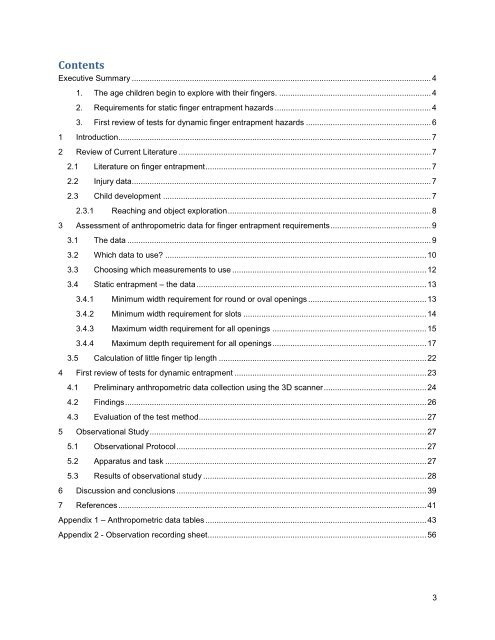Requirements for finger entrapment in European safety ... - ANEC
Requirements for finger entrapment in European safety ... - ANEC
Requirements for finger entrapment in European safety ... - ANEC
You also want an ePaper? Increase the reach of your titles
YUMPU automatically turns print PDFs into web optimized ePapers that Google loves.
Contents<br />
Executive Summary ...................................................................................................................................... 4<br />
1. The age children beg<strong>in</strong> to explore with their <strong>f<strong>in</strong>ger</strong>s. .................................................................... 4<br />
2. <strong>Requirements</strong> <strong>for</strong> static <strong>f<strong>in</strong>ger</strong> <strong>entrapment</strong> hazards ...................................................................... 4<br />
3. First review of tests <strong>for</strong> dynamic <strong>f<strong>in</strong>ger</strong> <strong>entrapment</strong> hazards ........................................................ 6<br />
1 Introduction ............................................................................................................................................ 7<br />
2 Review of Current Literature ................................................................................................................. 7<br />
2.1 Literature on <strong>f<strong>in</strong>ger</strong> <strong>entrapment</strong> ..................................................................................................... 7<br />
2.2 Injury data ...................................................................................................................................... 7<br />
2.3 Child development ........................................................................................................................ 7<br />
2.3.1 Reach<strong>in</strong>g and object exploration ........................................................................................... 8<br />
3 Assessment of anthropometric data <strong>for</strong> <strong>f<strong>in</strong>ger</strong> <strong>entrapment</strong> requirements ............................................. 9<br />
3.1 The data ........................................................................................................................................ 9<br />
3.2 Which data to use? ..................................................................................................................... 10<br />
3.3 Choos<strong>in</strong>g which measurements to use ....................................................................................... 12<br />
3.4 Static <strong>entrapment</strong> – the data ....................................................................................................... 13<br />
3.4.1 M<strong>in</strong>imum width requirement <strong>for</strong> round or oval open<strong>in</strong>gs ..................................................... 13<br />
3.4.2 M<strong>in</strong>imum width requirement <strong>for</strong> slots .................................................................................. 14<br />
3.4.3 Maximum width requirement <strong>for</strong> all open<strong>in</strong>gs ..................................................................... 15<br />
3.4.4 Maximum depth requirement <strong>for</strong> all open<strong>in</strong>gs ..................................................................... 17<br />
3.5 Calculation of little <strong>f<strong>in</strong>ger</strong> tip length ............................................................................................. 22<br />
4 First review of tests <strong>for</strong> dynamic <strong>entrapment</strong> ...................................................................................... 23<br />
4.1 Prelim<strong>in</strong>ary anthropometric data collection us<strong>in</strong>g the 3D scanner .............................................. 24<br />
4.2 F<strong>in</strong>d<strong>in</strong>gs ....................................................................................................................................... 26<br />
4.3 Evaluation of the test method...................................................................................................... 27<br />
5 Observational Study ............................................................................................................................ 27<br />
5.1 Observational Protocol ................................................................................................................ 27<br />
5.2 Apparatus and task ..................................................................................................................... 27<br />
5.3 Results of observational study .................................................................................................... 28<br />
6 Discussion and conclusions ................................................................................................................ 39<br />
7 References .......................................................................................................................................... 41<br />
Appendix 1 – Anthropometric data tables ................................................................................................... 43<br />
Appendix 2 - Observation record<strong>in</strong>g sheet .................................................................................................. 56<br />
3
















